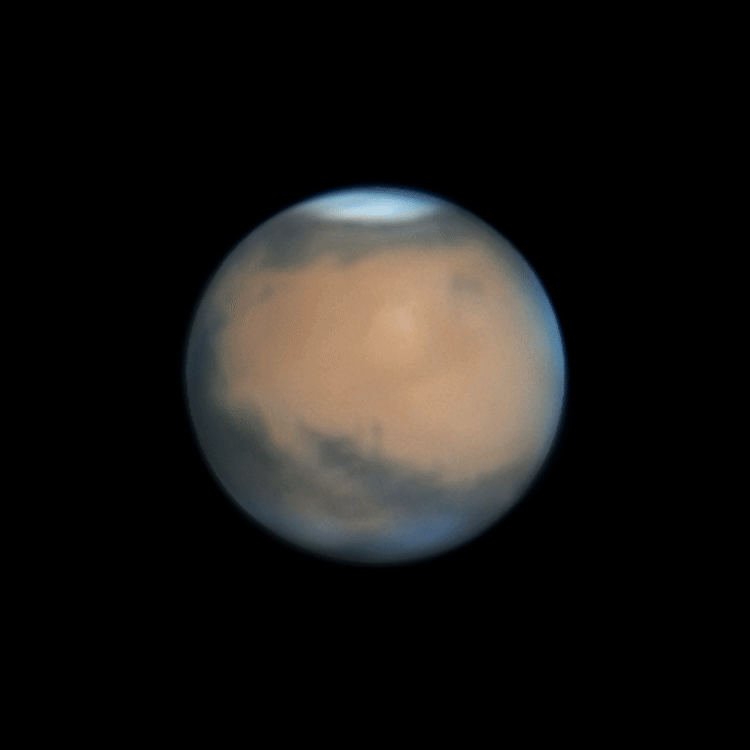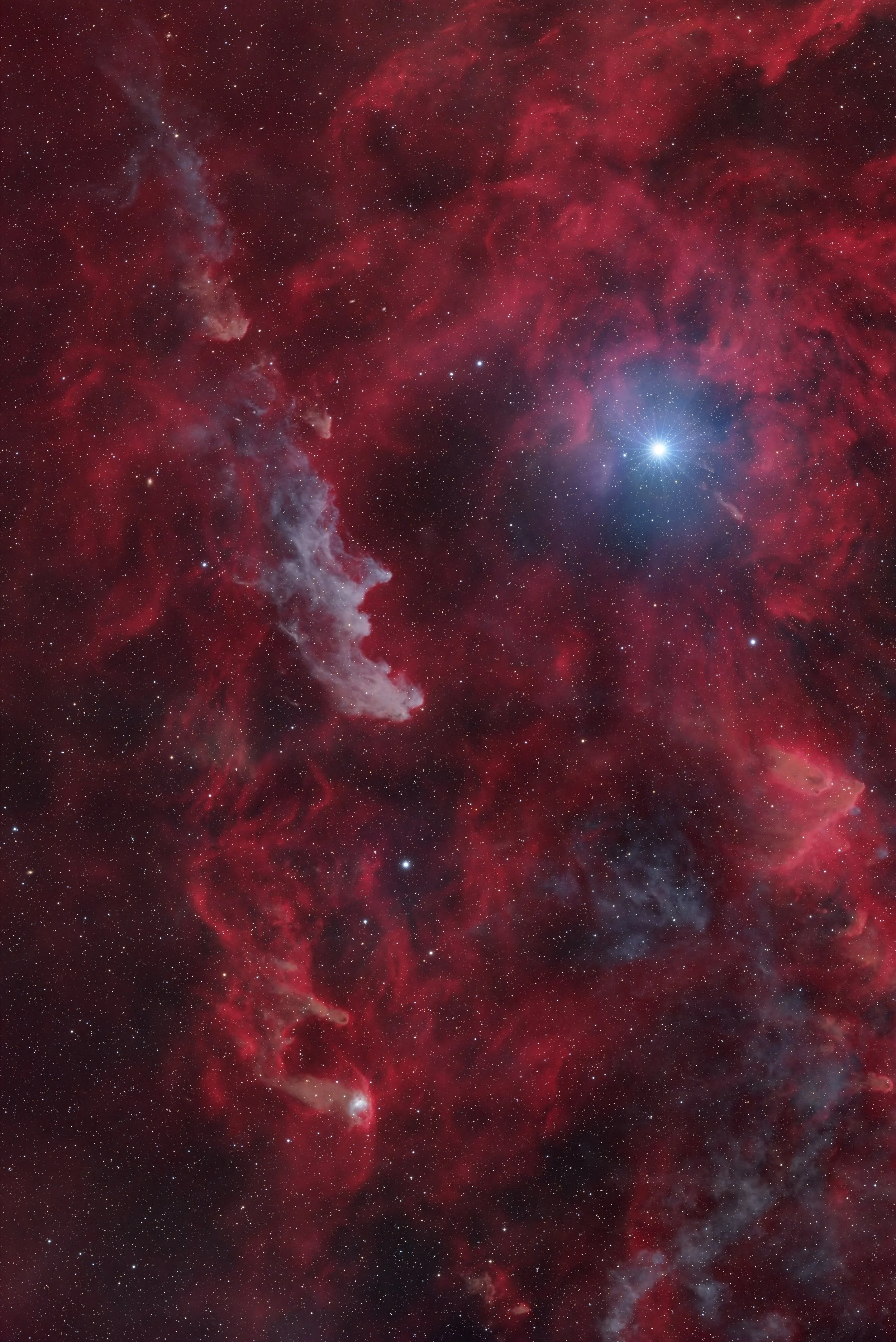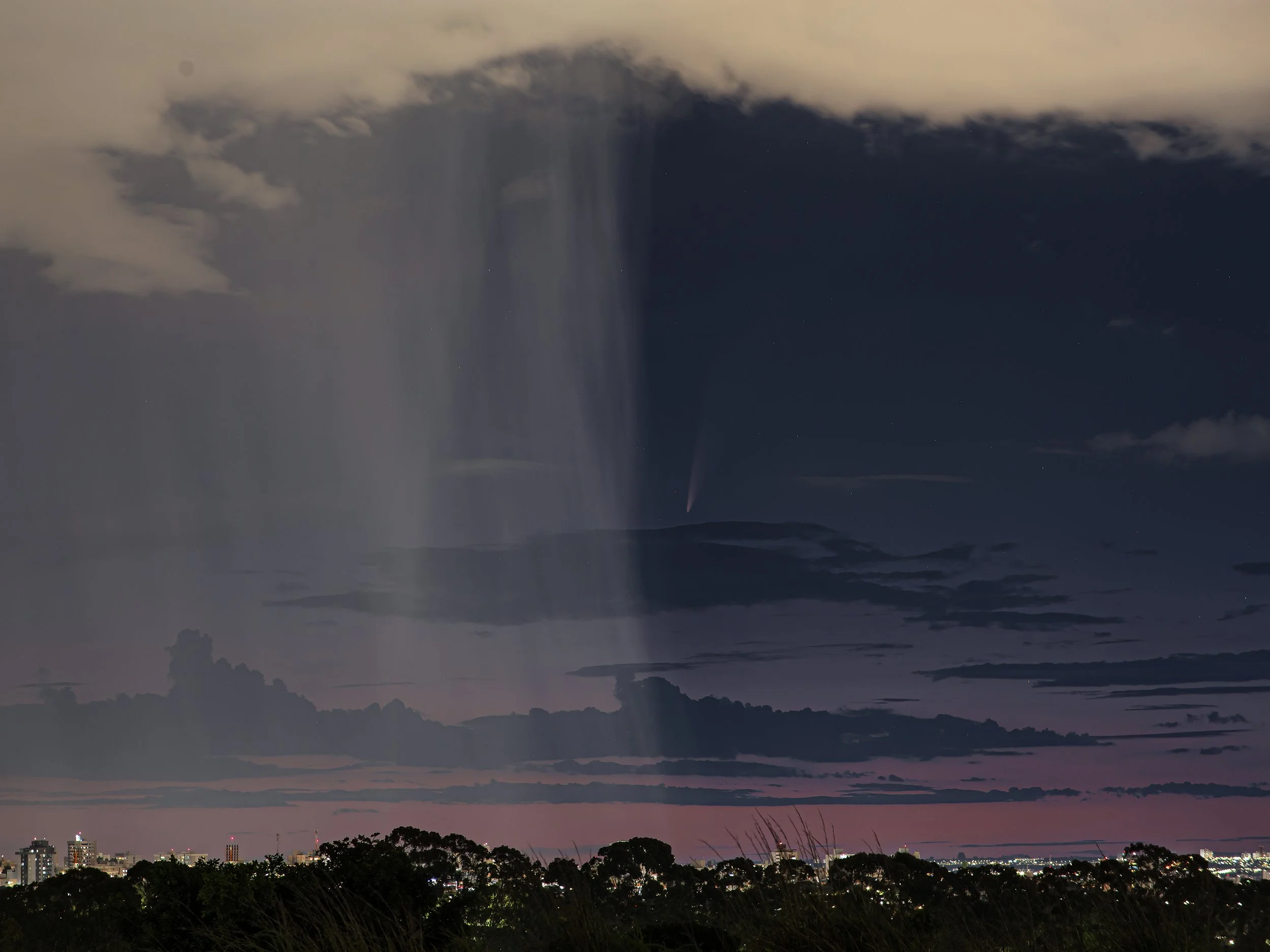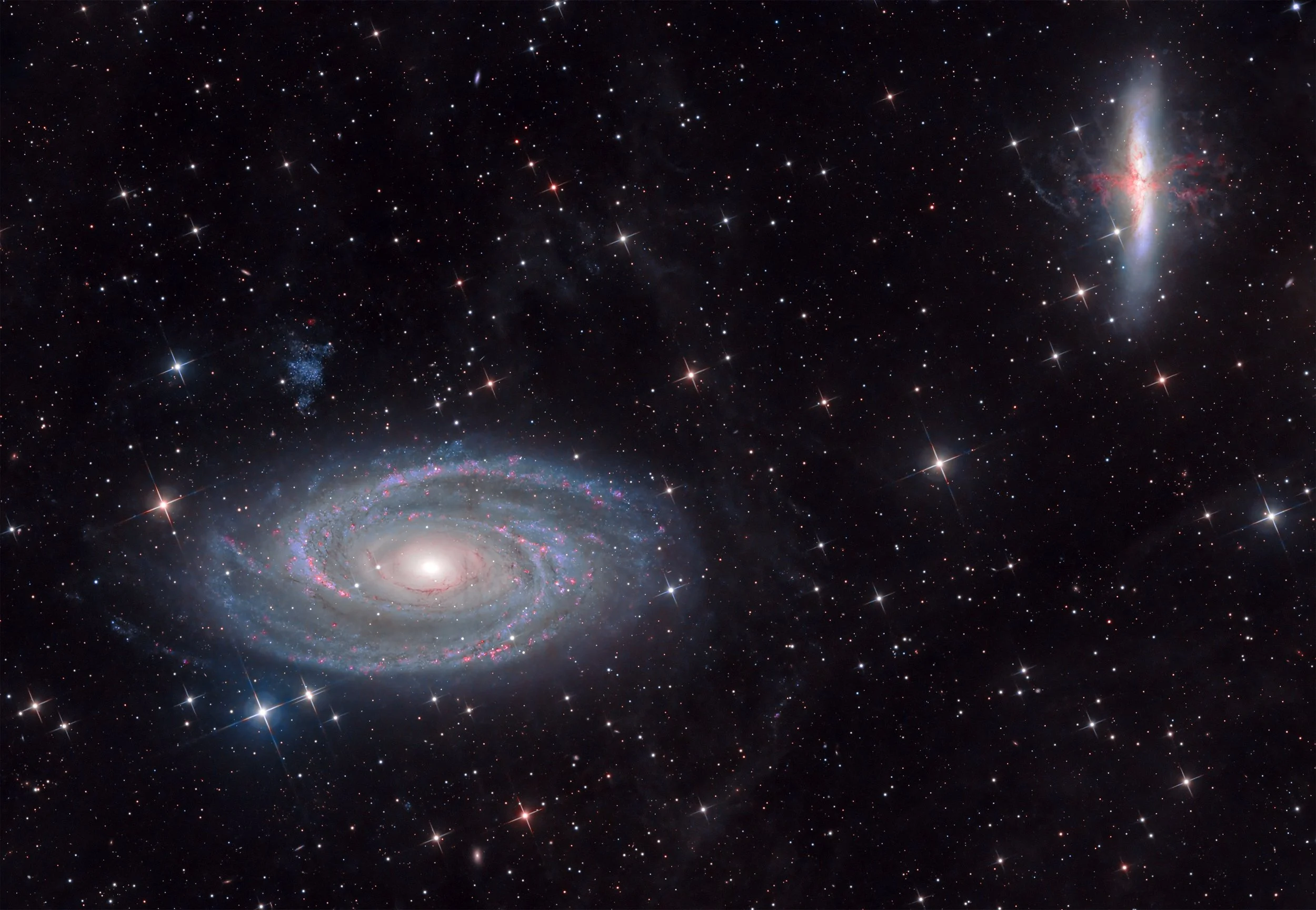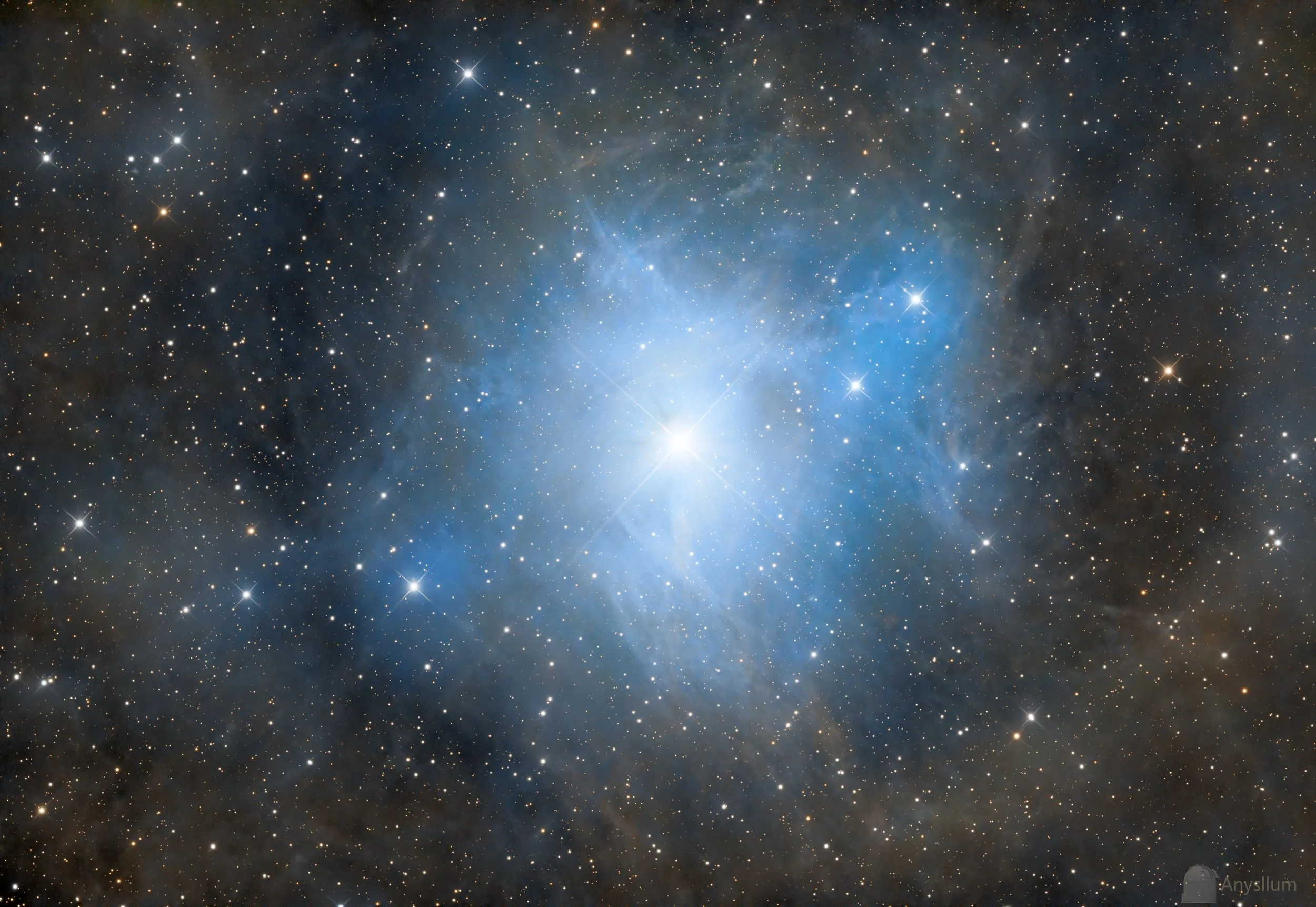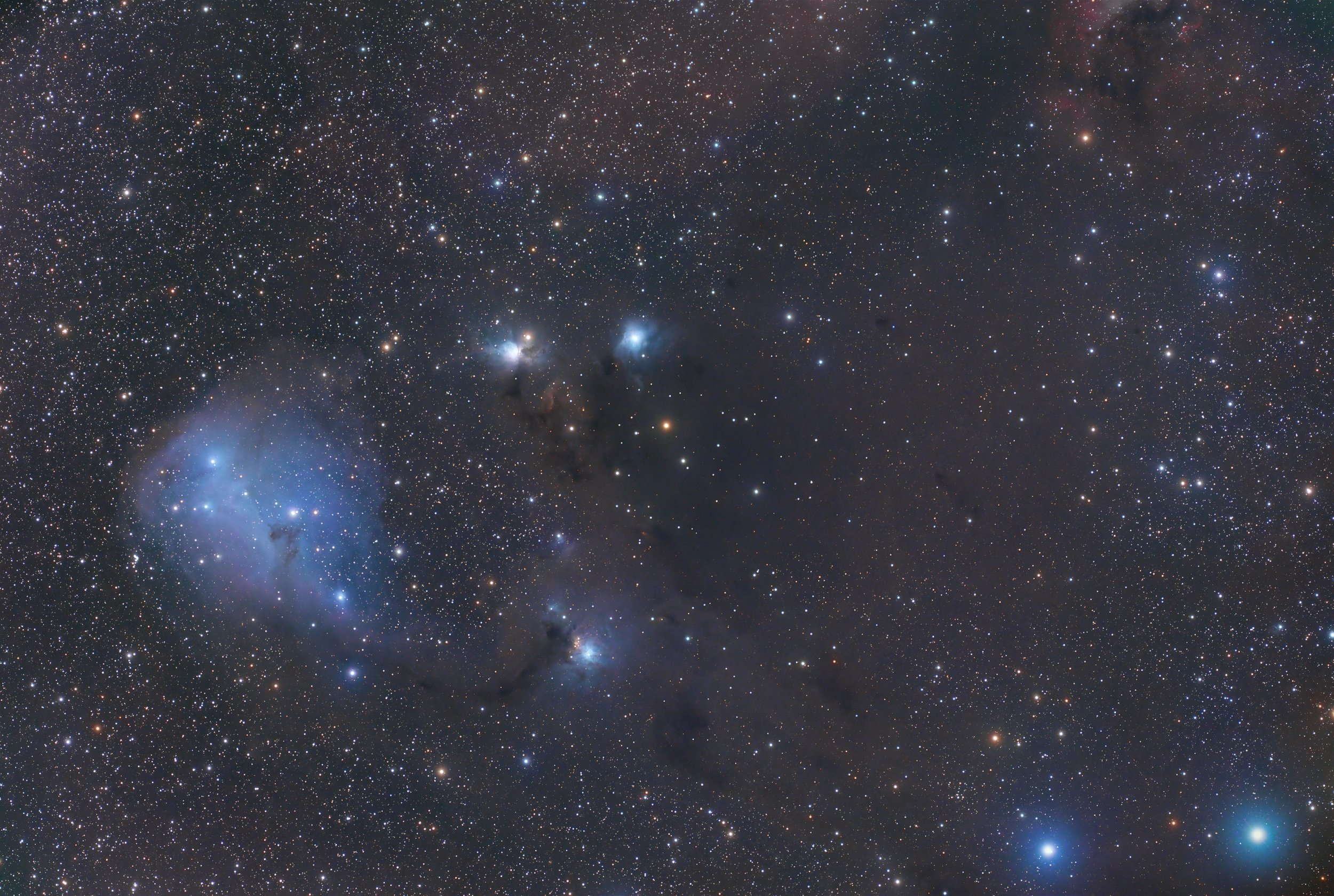
AAPOD2 Image Archives
Monoceros Space Garden: A Winter Mosaic
This mosaic captures two of the northern hemisphere’s winter classics—the Rosette Nebula and the Christmas Tree Cluster—nestled within the rich star fields of the Monoceros constellation. The Rosette Nebula, a vast star-forming region, glows with intricate filaments of ionized hydrogen, while the Christmas Tree Cluster, embedded within the Cone Nebula, adds a striking contrast with its young, hot stars shaping the surrounding gas and dust.
Captured from San Benedetto del Tronto, Italy, under Bortle 5 skies, this image combines narrowband and RGB data to enhance both the nebular structures and the surrounding starlight. The processing approach intensifies the dynamic interplay of colors while staying true to the physical emissions of ionized gases, creating a visually captivating yet scientifically grounded representation of this celestial landscape.
Rotation of Mars: A Dynamic View of the Red Planet
This animation captures an hour of Mars’ rotation, offering a rare glimpse into the planet’s ever-changing face. With a rotation period of 24.7 hours—remarkably close to Earth’s—Mars reveals its distinctive surface features in motion. The prominent carbon dioxide ice cap in the north stands out, while the planet’s thin atmosphere scatters light, producing subtle blue hues along the limb. Over the Elysium Mons region, delicate cloud formations drift, creating an almost three-dimensional effect as they shift with the planet’s rotation.
Captured from Murcia, Spain, this detailed sequence highlights the anticipation of Mars' closest approach, a moment that comes only once every two years. The animation showcases not just the planet’s geological diversity but also the dynamic nature of its weather patterns, making it a mesmerizing target for planetary observation.
HB3 Supernova
Hidden within the star-rich fields of Cassiopeia, the HB3 supernova remnant spans an immense 1.5° × 2° region of the sky. Estimated to have formed around 40,000 years ago, this ancient stellar explosion has left behind an intricate web of diffuse shockwaves and ionized gas. Situated near the more prominent IC 1705 (the Fish Nebula) and IC 1805 (the Heart Nebula), HB3 remains a challenging target due to its extremely faint emission.
Captured from Ager, Lleida, Spain, this deep exposure also reveals two planetary nebulae—PN G132.8+02.0 and PK131+02.1 (Abell 3)—delicate reminders of the quieter stellar deaths that contrast with HB3’s violent past. The image highlights the complexity of the interstellar medium, where remnants of stellar life cycles blend into the cosmic landscape, shaping the future of star formation.
IC 443, IC444, Sh2-249
IC 443, IC 444, and Sh2-249: A Cosmic Trio in Gemini
This captivating view in the constellation Gemini features the Jellyfish Nebula (IC 443), a supernova remnant with glowing tendrils of ionized gas, accompanied by the reflection nebula IC 444 and the faint emission region Sh2-249. IC 443 is the aftermath of a stellar explosion, with shockwaves shaping its intricate structure, while IC 444’s blue reflection comes from interstellar dust scattering the light of nearby stars. Sh2-249 provides a faint, reddish backdrop, completing this celestial trio.
Captured from Guidonia Montecelio, Italy, the image showcases the diversity of nebular forms and the dynamic processes shaping the interstellar medium. These structures illustrate the life and death of stars, from violent supernova remnants to tranquil regions of light and dust.
Rigel to the Witch Head Nebula and more
This wide-field view captures the dazzling blue supergiant star Rigel, the brightest star in Orion, and its spectral neighbor, the Witch Head Nebula (IC 2118). Rigel’s intense ultraviolet light illuminates the Witch Head, creating its ghostly blue glow as it reflects off interstellar dust. The intricate textures of the nebula resemble a witch's profile, adding a mythical touch to this cosmic scene.
Captured from SFRO in Texas, the image reveals the delicate interplay of light and dust stretching across this region of Orion. Surrounding faint nebulosity and subtle interstellar structures add depth to the composition, showcasing the vast, interconnected beauty of this celestial landscape. This dynamic pairing of star and nebula exemplifies the radiant harmony of the Orion region.
vdB 87
vdB 87 is a reflection nebula nestled in the constellation Cygnus, approximately 2,600 light-years from Earth. Its ethereal blue glow results from starlight scattering off nearby interstellar dust, creating a soft, ghostly illumination against the surrounding darkness. The nebula is part of a rich and complex region of star formation, adding depth to its celestial environment.
Captured from the Deep Sky West remote observatory near Santa Fe, NM, this image highlights vdB 87’s delicate structure and subtle contrasts. Reflection nebulae like vdB 87 are a visual testament to the interplay of light and matter, showcasing the quiet, luminous beauty hidden within the vast expanses of the Milky Way.
THE COMET AND THE RAIN
The comet C/2024 G3 (ATLAS) graces the skies with its delicate greenish coma and faint, wispy tail, composed of sublimating ices and dust swept back by solar radiation and winds. This icy traveler, hailing from the outer reaches of the Solar System, offers a fleeting glimpse of primordial material left over from the formation of planets.
Captured from the urban perimeter of Uberlândia, Brazil, during a break in torrential rain, this fortuitous observation demonstrates the unpredictability of celestial phenomena and the persistence of astrophotgraphers. The comet’s dynamic appearance, shaped by its interaction with the Sun, reminds us of the transient beauty of these cosmic visitors as they pass through our skies.
M81 and M82: A Galactic Duo in Contrast
In the northern skies of Ursa Major, the galaxies M81 (Bode’s Galaxy) and M82 (the Cigar Galaxy) form a stunning pair of contrasting cosmic neighbors, separated by only about 150,000 light-years. M81, a grand spiral galaxy, exhibits elegant, sweeping arms filled with billions of stars and interstellar dust. Nearby, M82’s edge-on orientation reveals a tumultuous starburst galaxy, where intense star formation and powerful winds from massive stars drive outflows of hydrogen gas, glowing prominently in Hα light.
This composite image combines data captured in LRGB from Tibolddaróc, Hungary, under Bortle 3-4 skies, with Hα data acquired from Budapest’s Bortle 5-6 urban skies. The detailed processing highlights M81’s serene spiral structure alongside M82’s energetic outflows, showcasing the diversity of galactic evolution. This iconic pair invites exploration into the dynamic interactions and gravitational influences that shape galaxies across the cosmos.
Sh2-308: The Dolphin-Head Nebula
Sh2-308, also known as the Dolphin-Head Nebula, is a striking bubble of ionized gas in the constellation Canis Major, located approximately 4,500 light-years from Earth. This delicate structure is the result of intense stellar winds emanating from a massive Wolf-Rayet star at its center, sculpting the surrounding material into a luminous shell. The faint blue glow is dominated by oxygen-III emissions, which shine brightly in the ultraviolet light of the central star.
Captured from Rio Hurtado, Chile, using a remote commercial observatory, this view reveals the ethereal beauty of Sh2-308’s expanding shell. Spanning nearly 60 light-years, the nebula is a transient structure in the cosmos, lasting only a few tens of thousands of years. Its intricate shape and soft glow provide a unique glimpse into the life cycle of massive stars and the dynamic processes that shape the interstellar medium.
Jupiter and the Great Red Spot
Jupiter, the largest planet in the Solar System, takes center stage in this stunning view. Its swirling cloud bands and intricate patterns reveal the dynamic nature of the planet’s atmosphere. The iconic Great Red Spot (GRS), a massive anticyclonic storm larger than Earth, dominates the southern hemisphere, showcasing its deep reddish hues and turbulent surroundings.
Captured from Rome, Italy, using high-resolution imaging techniques, this view highlights Jupiter’s immense scale and complex weather systems. The contrast between the GRS and the adjacent bright and dark cloud zones provides a vivid snapshot of the gas giant’s ongoing atmospheric activity, a spectacle that has fascinated astronomers for centuries.
LDN 1436, LDN 1438, and a Supernova Remnant: A Dark and Fiery Tapestry
In the constellation Taurus, the dark nebulae LDN 1436 and LDN 1438 stand as intricate patterns of interstellar dust, silhouetted against the luminous backdrop of the Milky Way. These dense clouds obscure the light of background stars, offering a striking contrast between the dark voids and the sparkling star field. Adding to the complexity of the region is a faint supernova remnant, whose glowing filaments weave through the scene, the aftermath of a stellar explosion that scattered elements into the surrounding space.
Captured from Fumanya, Catalonia, Spain, using a personal telescope setup, this image reveals the juxtaposition of cosmic destruction and quiet beauty. The delicate interplay of dark nebulae and the supernova remnant speaks to the duality of the universe, where the end of one star’s life contributes to the rich tapestry of material for future stars and nebulae. This celestial composition invites viewers to explore the ongoing cycles of creation and transformation within our galaxy.
Alves 2: A Dark Nebula in Taurus
Alves 2 is a subtle and enigmatic dark nebula nestled in the constellation Taurus. Part of a larger complex of interstellar dust, it obscures the light from background stars, appearing as an inky void against the dense star fields of the Milky Way. Its faint structure requires long exposures and precise imaging to reveal the intricate shapes and textures of the dust clouds.
Captured from a backyard in Cartagena, Spain, on January 2, 2025, Brendan Kinch’s image showcases the delicate beauty of Alves 2 using a personal telescope setup. This challenging target emphasizes the quiet mystery of dark nebulae, where dense molecular clouds serve as potential cradles for star formation. Hidden within its shadows may lie the seeds of future stars, illustrating the silent yet essential role of dark nebulae in the cycle of cosmic evolution.
Firefox Nebula
The Firefox Nebula, a lesser-known yet captivating emission nebula, resides in the constellation Orion. Its fiery appearance, characterized by glowing red and orange hues from hydrogen-alpha emissions, is accentuated by intricate filaments shaped by stellar winds and radiation. This nebula is a stellar nursery, where young, hot stars ignite the surrounding gas, creating a radiant, flame-like effect that lends the nebula its name.
Captured from Morocco, this observation benefits from the pristine skies of the Atlas Mountains. The Firefox Nebula's striking structure and vivid colors stand out against the inky backdrop, offering a glimpse into the life cycles of stars. Its radiant beauty and dynamic interplay of light and gas embody the fiery creativity of the cosmos, an ever-evolving masterpiece shaped by the forces of nature.
Vdb 152
VdB 152, also known as the Wolf's Cave Nebula, is a stunning reflection nebula nestled in the constellation Cepheus, approximately 1,400 light-years away. This delicate structure appears as a faint, bluish glow caused by starlight reflecting off surrounding interstellar dust. The nebula is part of a dense molecular cloud that obscures the light from background stars, creating a dramatic interplay of light and shadow.
Captured from southern Portugal over 24 hours in LRVB, Hα, and OIII, this long exposure reveals the nebula's faint, ethereal features. Intricate filaments of hydrogen-alpha and oxygen-III emissions enhance the view, showcasing regions of subtle ionization and interstellar activity. The nickname "Wolf's Cave" evokes its mysterious, enclosed appearance, where light seems to emerge from the darkness, illustrating the quiet beauty of cosmic processes shaping the galaxy.
Deneb: A Stellar Beacon in Cygnus
Deneb, one of the brightest stars in the night sky, is a luminous supergiant located approximately 2,600 light-years away in the constellation Cygnus. As the anchor of the Summer Triangle and the tail of the celestial Swan, Deneb shines with a magnitude of 1.25, making it visible even in light-polluted areas. Its staggering luminosity—nearly 200,000 times that of the Sun—places it among the most luminous stars known, marking it as a key point of interest for astronomers.
Captured from Annecy, France, during a brief window before a major target rose, Deneb's brilliance dominates the field, its blue-white light hinting at its surface temperature of about 8,500 K. Deneb's role as the ionizing source for the nearby North America and Pelican Nebulae adds to its allure, emphasizing its influence on the surrounding interstellar medium. Even as an impromptu target, this celestial gem reveals the grandeur of the cosmos with stunning clarity.
VdB 10 - Reflection nebula in Perseus
VdB 10, a striking blue reflection nebula in the constellation Cassiopeia, lies approximately 1,000 light-years away. This delicate nebula reflects the light of a nearby star, creating a soft, ethereal glow. Accompanying it is LBN 680, a faint and complex region of interstellar dust and gas. Together, these structures illustrate the interplay of starlight and cosmic material in the Milky Way, with VdB 10’s bright, scattered light contrasting beautifully against the darker, more subdued textures of LBN 680.
This view was captured from Ager in Lleida, Spain, using a personal telescope setup under pristine skies. The intricate details of these nebulae require long exposures to reveal their subtle beauty, making them a rewarding target for astrophotographers. The scene highlights the hidden treasures of the night sky, where seemingly empty spaces come alive with light, shadow, and the whispers of star-forming processes.
The Star Clusters of Cassiopeia: A Stellar Showcase
The rich starfields of Cassiopeia host a stunning array of celestial wonders, highlighted by the open star clusters NGC 654, NGC 659, NGC 663, and IC 166. These clusters, lying roughly 7,000 to 8,000 light-years away, are scattered across the Perseus arm of the Milky Way, each hosting dozens to hundreds of young, hot stars. Their bluish hues and tight groupings stand out against the dense backdrop of the Milky Way, making them a captivating sight for both observers and astrophotographers.
Adding depth to the scene are several dark nebulae, including LDN 1337, whose dense clouds of interstellar dust obscure the light from stars behind them. Captured from Hannover, Germany, using a personal telescope setup, this view combines bright and dark regions to showcase the complexity of our galaxy’s structure. The interplay of vibrant star clusters and shadowy nebulae reminds us of the dynamic processes shaping the cosmos, from star birth to the formation of intricate dust clouds.
Saturn and the Moon: A Celestial Encounter
On January 4, 2025, Saturn emerged from behind the Moon in a breathtaking occultation event. Captured at this moment, the southern lunar surface showcases its densely cratered terrain, including striking features such as Clavius and Tycho, whose dramatic shadows accentuate the Moon’s rugged beauty. Saturn, with its iconic ring system tilted gracefully, adds a touch of elegance to this dynamic scene, its golden hue contrasting against the stark, gray lunar surface.
Nearby, the bright star 85 Aquarii adds its light to the composition, a distant companion to this celestial alignment. Such occultations provide a rare and awe-inspiring perspective on the Solar System, illustrating the intricate motions of planetary bodies as viewed from Earth. The juxtaposition of the Moon’s craters, Saturn’s rings, and the distant starlight reminds us of the vast scales and intricate beauty of the universe.
A Supernova’s Legacy": GUM 16 - Vela SNR
Gum 16, an expansive emission nebula in the constellation Vela, lies intertwined with the Vela Supernova Remnant, a spectacular tapestry of gas and dust created by the explosive death of a massive star approximately 11,000 years ago. Gum 16 is part of the greater Gum Nebula, one of the largest known emission regions, spanning hundreds of light-years. Within this complex lies the legacy of stellar death and renewal, as shockwaves from the supernova interact with nearby molecular clouds, triggering new star formation.
Captured from Hillcrest, QLD, Australia, under Bortle 6 skies, the intricate details of this region are revealed through a mix of glowing hydrogen gas and tangled filaments of the supernova remnant. The Vela Pulsar, a rapidly spinning neutron star, continues to energize the surrounding material with powerful jets of radiation. Together, Gum 16 and the Vela SNR present a vivid portrait of the interconnected life cycles of stars, where destruction becomes a catalyst for creation in the ever-changing cosmos.
WR134 and her friends (94 hours)
WR 134, a massive Wolf-Rayet star in the constellation Cygnus, anchors a dramatic cosmic scene surrounded by her "friends"—neighboring stars and intricate nebulae shaped by their stellar winds. This luminous blue star, approximately 6,000 light-years away, is in a late, short-lived phase of stellar evolution, shedding mass through intense winds at speeds exceeding 1,000 kilometers per second. The energetic interactions between these winds and the surrounding interstellar medium have sculpted a delicate bubble of ionized gas, glowing faintly in hydrogen-alpha light.
This stunning portrait of WR 134 and her companions was the result of a collaborative 94-hour imaging effort by four amateur astrophotographers. Working together with hydrogen-alpha and oxygen-III filters, they captured the faint structures surrounding WR 134, along with contributions from nearby Wolf-Rayet stars like WR 135 and WR 136. Their combined skill and dedication reveal the ephemeral beauty of massive stars near the end of their lives, enriching the cosmos with heavy elements and energy as they prepare for their ultimate fate as supernovae.



